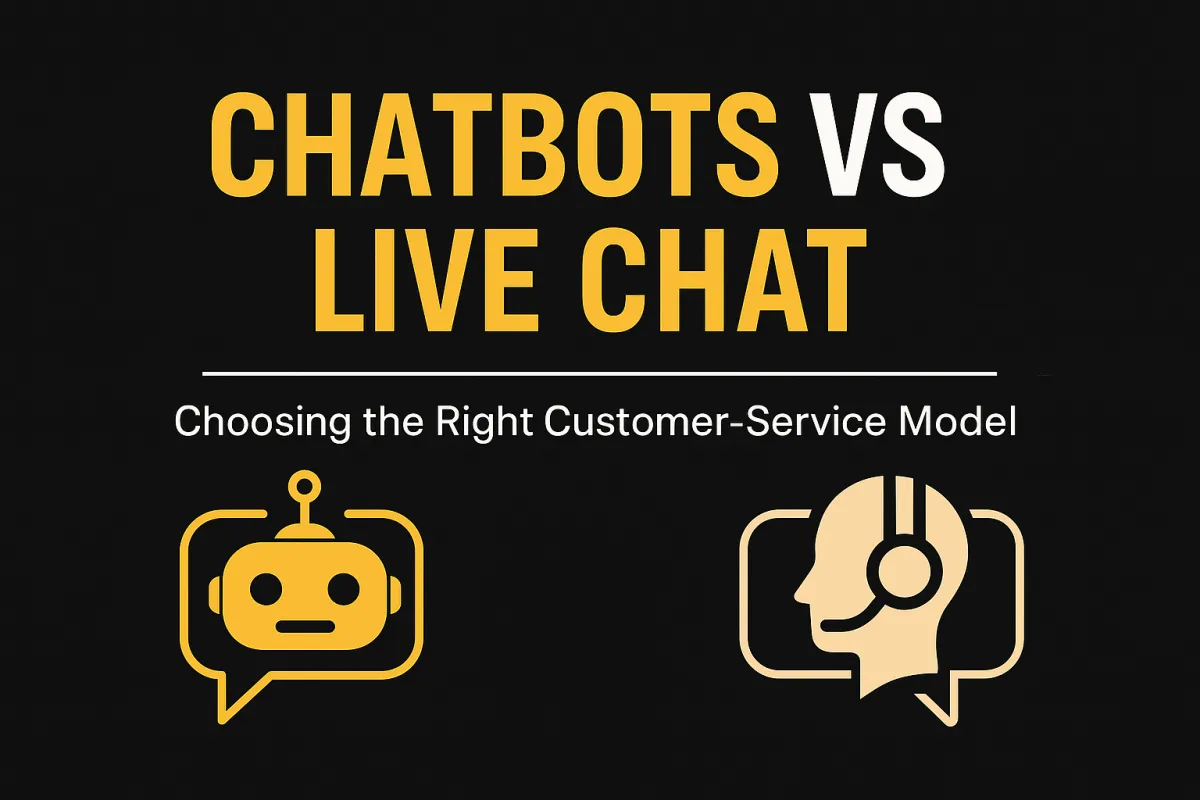
Chatbots vs. live chat: choosing the right customer‑service model
Chatbots vs Live Chat: Choosing the Right Customer-Service Model
Introduction
In today’s digital economy, lightning-fast customer service can make or break a brand. Did you know that 90% of customers say an “immediate” response is essential when they have a customer service question? With consumer expectations rising and competition intensifying, businesses must make critical decisions about how they manage customer service interactions. Should they rely on AI-powered chatbots, leverage human-powered live chat, or strike a balance between the two?
This comprehensive guide explores the two most prominent customer service models—chatbots and live chat—to help entrepreneurs, marketers, and business professionals decide which approach best aligns with their objectives. You’ll learn how each model works, examine their pros and cons, explore emerging customer service trends for 2025, and get practical steps for implementing the ideal approach in your business.
Whether you're scaling a large enterprise or launching a startup, this guide provides actionable insights and a future-ready perspective to improve customer service, drive satisfaction, and ultimately boost your brand’s success.
Ready to choose the customer communication tool that fits your strategy? Let’s dive in.
Understanding Chatbots and Live Chat
What Are Chatbots?
Chatbots are AI-driven tools that simulate human conversation to interact with users. They’re commonly implemented on websites, mobile apps, and social platforms to answer questions, process transactions, or perform automated tasks.
Key features of chatbots include:
Automation of repetitive interactions
24/7 availability regardless of time zones
Seamless handling of vast conversation volumes
For example, e-commerce sites use chatbots to answer FAQs about orders, shipping, and return policies. By eliminating redundant queries for human agents, chatbots significantly improve efficiency and reduce operational costs.
Historically, chatbots were rules-based. Today, Natural Language Processing (NLP) and machine learning have enabled conversational bots to understand context, intent, and sentiment more effectively.
What Is Live Chat?
Live chat is a real-time customer support channel that connects visitors or app users directly with human service agents. Customers typically use live chat when they need quick help solving a problem or have complex, high-value questions requiring empathy and nuance.
Key benefits of live chat include:
Authentic human-to-human interaction
Personalized responses
Strong problem-solving for complex issues
Key Differences Between Chatbots and Live Chat
Response Time: Chatbots offer instant, 24/7 support, while live chat depends on agent availability.
Customer Experience: Live chat offers empathy and personalization; chatbots provide speed and scale.
Complexity: Chatbots excel at simple workflows; live chat is better for nuanced problems.
Scalability: Chatbots scale infinitely; live chat is limited by staffing.
Pros and Cons of Chatbots and Live Chat
Pros of Chatbots
24/7 availability
Scalable to thousands of users
Cost-effective
Consistent responses
Cons of Chatbots
Limited comprehension for unusual queries
Frustration with rigid scripts
Lack of emotional intelligence
Require ongoing optimization
Pros of Live Chat
Dynamic, adaptive conversations
Builds trust and rapport
Great for high-ticket services
Upselling and cross-selling potential
Cons of Live Chat
Higher staffing and training costs
Limited by business hours
Queue delays during peak periods
Knowledge inconsistencies between agents
Customer Service Trends in 2025
Proactive Support: AI predicts and resolves issues before customers ask.
AI + Human Collaboration: Hybrid models integrate chatbots and agents seamlessly.
Omnichannel Service: Customers expect unified support across chat, email, social, SMS, and voice.
Emerging Tech: AR-powered chatbots help users troubleshoot visually.
How to Choose Between Chatbots, Live Chat, or Both
Factors to Consider:
Business Size: Larger volume → Chatbots.
Complexity: Technical or sensitive issues → Live chat.
Budget: Chatbots save costs; hybrids balance cost + experience.
Brand Voice: Premium brands lean on human touch.
Effective Strategies to Master the Concept
Define Support Goals – Reduced ticket volume? Higher CSAT? More conversions?
Map Common Queries – Use CRM + analytics to identify FAQs.
Build AI Chatbots – Launch bots with Go HighLevel for FAQs and onboarding.
Design Escalation Workflows – Smoothly pass complex cases to humans.
Train Live Chat Agents – Product knowledge + empathy are essential.
Secure Systems – Protect chat with Cloudflare and proper encryption.
Monitor & Optimize – A/B test scripts, measure CSAT, refine workflows.
Common Mistakes Businesses Should Avoid
Over-Relying on Chatbots Alone – Customers still want human interaction for complex issues.
Failing to Train Live Chat Agents – Knowledge gaps create poor experiences.
Ignoring Escalation Paths – Bots without human backup frustrate users.
Neglecting Security & Compliance – Customer chats may include sensitive data—protect it.
Not Tracking Performance Metrics – Without measuring satisfaction, first-response time, and resolution rates, you can’t improve.
Frequently Asked Questions
Q1: Are chatbots replacing human agents?
No. Chatbots are best for FAQs and simple workflows. Human agents are vital for empathy-driven or complex support.
Q2: Can small businesses use chatbots effectively?
Yes. Affordable tools like Go HighLevel make chatbot integration accessible even for startups.
Q3: What’s the best approach—chatbots or live chat?
Often, a hybrid model is most effective: chatbots handle common queries, live chat takes over when nuance is required.
Q4: How can I measure chatbot and live chat success?
Track CSAT (customer satisfaction), FRT (first response time), and resolution rates via Google Analytics, CRMs, or built-in dashboards.
Conclusion
Customer service is no longer optional—it’s a competitive differentiator. Chatbots deliver speed and scale, while live chat brings empathy and personalization. The smartest businesses in 2025 won’t see this as an “either/or” decision but as a hybrid strategy that blends automation with human expertise.
By combining the scalability of AI with the authenticity of live interaction, you can elevate customer satisfaction, strengthen loyalty, and gain a true competitive edge.
Next Step: Ready to optimize your customer support? Explore our digital solutions to integrate AI-powered chat and live human support for a balanced, future-proof system.
